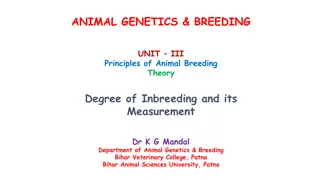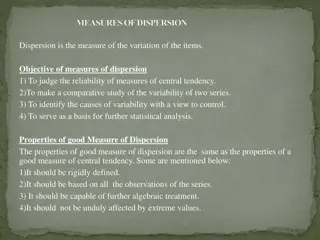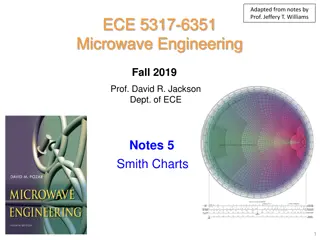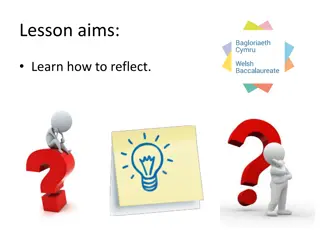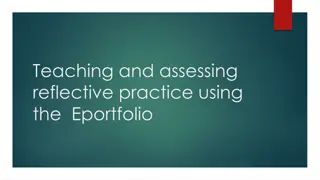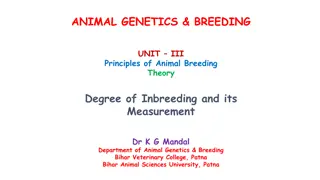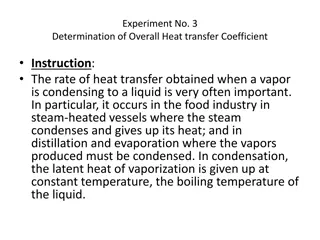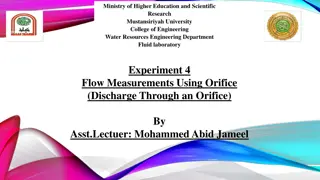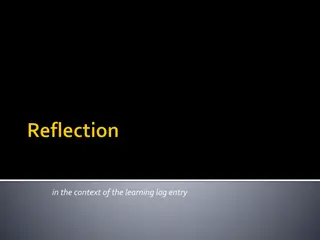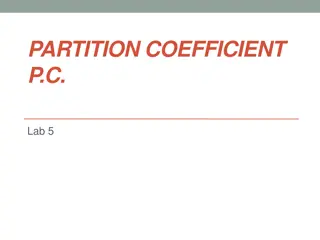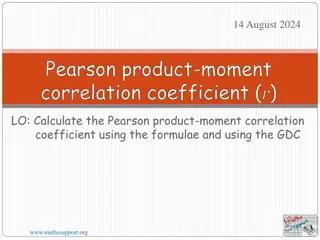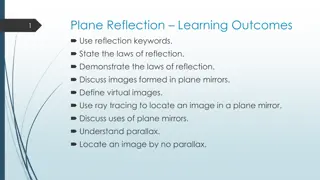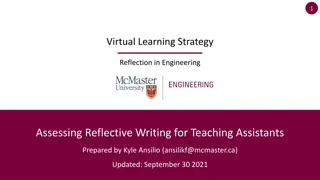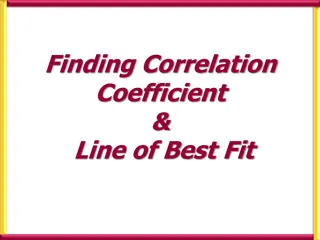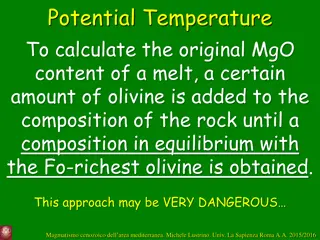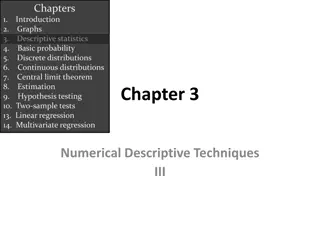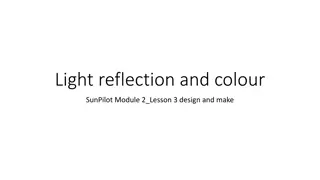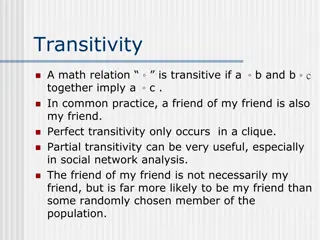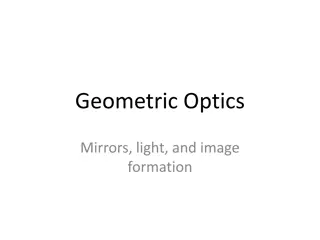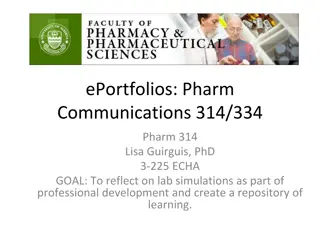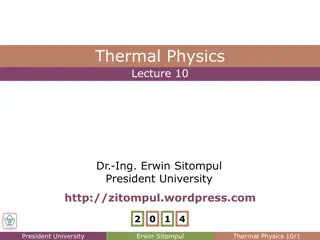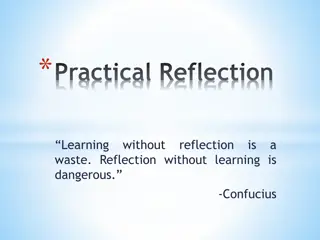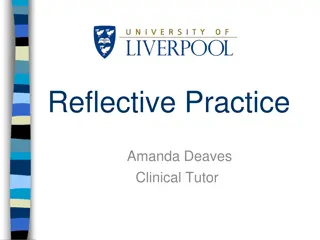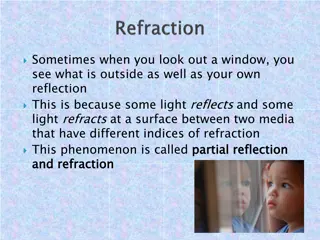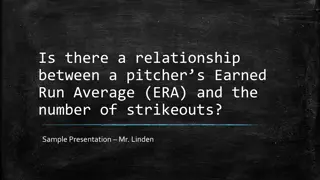ACTIVE LEARNING Reflection and reflective writing
Explore the concepts of active learning, reflection, and reflective writing in education. Learn how reflection enhances problem-solving skills, flexibility in learning, and self-improvement. Discover the benefits of reflecting, the process of reflection, and how to apply active learning strategies e
7 views • 20 slides
Understanding Multicollinearity in Regression Analysis
Multicollinearity in regression occurs when independent variables have strong correlations, impacting coefficient estimation. Perfect multicollinearity leads to regression model issues, while imperfect multicollinearity affects coefficient estimation. Detection methods and consequences, such as incr
1 views • 11 slides
Understanding Degree of Inbreeding in Animal Genetics and Breeding
Degree of inbreeding refers to the extent to which an individual carries genes identical by descent. This concept is crucial in animal breeding as it affects genetic diversity and homozygosity in offspring. The coefficient of inbreeding is used to measure the level of inbreeding, with higher values
1 views • 30 slides
Understanding Measures of Dispersion in Statistics
Measures of dispersion in statistics help in understanding the variability of data points. They are essential for assessing the reliability of central tendency measures, comparing data sets, identifying variability causes, and guiding further statistical analysis. The properties of a good measure of
0 views • 8 slides
Understanding Reflection and Refraction of Light
Explore the fascinating world of reflection and refraction of light, delving into concepts such as the laws of reflection, real vs. virtual images, characteristics of mirror-formed images, and the types of spherical mirrors - concave and convex. Discover how light behaves when it interacts with diff
1 views • 23 slides
Understanding Smith Charts in Microwave Engineering
Explore the concepts of Smith Charts in microwave engineering, focusing on the Generalized Reflection Coefficient, Complex Plane representation, Z-Chart analysis, and equation derivations for circles in the Z-Plane. Learn how to interpret impedance transformations and visualize impedance matching us
0 views • 29 slides
Mastering Reflection for Personal Growth
Explore the art of reflection through insightful lesson aims, objectives, and practical exercises. Understand the importance of reflective practice, learn from experiences, and discover how reflection enhances personal development. Engage in post-match analysis and reflective tasks to deepen your un
0 views • 15 slides
Understanding Joule-Thomson Coefficient in Thermodynamics
The Joule-Thomson coefficient describes the relationship between temperature and pressure changes in a substance. This coefficient impacts the direction of temperature change when pressure is altered. With equations and explanations provided by U. Nithya, M.Sc., M.Phil., this summary covers the defi
2 views • 11 slides
Enhancing Reflective Practice Using Eportfolios
Reflective practice is a metacognitive process crucial for self-understanding and future action. Utilizing Eportfolios in teaching and assessing reflection helps trainees develop critical thinking skills. The session plan includes discussion on educator comments, exploring Eportfolios, and strategie
0 views • 16 slides
Understanding Physicochemical Properties of Drugs
The physicochemical properties of drugs play a crucial role in their pharmacological effects. These properties include physical and chemical characteristics that influence interactions with biomolecules. Solubility, partition coefficient, and dissociation constant are key factors affecting drug beha
1 views • 46 slides
Understanding Degree of Inbreeding and its Measurement in Animal Genetics and Breeding
Degree of inbreeding in animals is the extent to which genes are identical by descent within an individual. The coefficient of inbreeding, denoted by F, measures this degree and represents the increase in homozygosity in offspring from closely related matings. Two sources of homozygosity are genes a
0 views • 15 slides
Determination of Overall Heat Transfer Coefficient in Steam Condenser Experiment
The experiment focuses on determining the overall heat transfer coefficient in a steam condenser, crucial for industries like food processing, distillation, and evaporation. A shell-and-tube heat exchanger setup is used with a steam boiler, measuring the heat transfer rate during vapor condensation.
0 views • 18 slides
Flow Measurements Using Orifice: Experiment in Fluid Laboratory
Understanding the principles of flow measurement through an orifice meter is essential in engineering. This experiment aims to determine the discharge coefficient of an orifice meter, analyzing the theoretical aspects and addressing sources of error such as mechanical losses and the vena contracta.
3 views • 13 slides
Enhancing Learning Through Reflection: Insights and Action
Reflecting on experiences in the context of learning log entries can lead to new insights, learning, and personal growth. The process of reflection involves reviewing, analyzing, and evaluating experiences while drawing on theoretical concepts. Having a good attitude, open-mindedness, and essential
1 views • 15 slides
Understanding Partition Coefficient in Pharmaceuticals
Partition coefficient (P.C.) is crucial in pharmaceuticals for various reasons such as preserving oil/water systems, drug distribution in the body, extraction processes, and dosage form formulations. It involves the distribution of a solute between two immiscible liquids based on equilibrium express
0 views • 10 slides
Understanding Pearson Product-Moment Correlation Coefficient
Pearson product-moment correlation coefficient, denoted by "r," is a numerical measure of the strength and direction of a linear relationship between two variables. It ranges from -1 to +1, where 1 signifies a perfect positive linear correlation, -1 a perfect negative linear correlation, and 0 no co
0 views • 18 slides
Understanding Reflection in Plane Mirrors
Explore the laws and principles of reflection in plane mirrors through detailed explanations and visual demonstrations. Learn about diffuse and specular reflection, virtual images, ray tracing techniques, and the significance of parallax. Discover how to locate images using reflection and understand
0 views • 17 slides
Enhancing Online Courses Through Reflection: Dr. Jill Channing's Insights
Explore the significance of integrating reflection into online courses with Dr. Jill Channing's expert guidance. Discover how reflection boosts metacognition, improves learning outcomes, and enhances teaching strategies, all within a social learning framework that focuses on interactions and connect
0 views • 24 slides
Enhancing Reflective Writing in Engineering: A Guide for Students and Teaching Assistants
This course module series aims to improve reflective writing skills for engineering students, teaching assistants, and instructors. It covers the definition of reflection, its importance in learning and professional development, and practical strategies for effective written reflection. The content
0 views • 36 slides
Self-Reflection in Healthcare: Importance, Definitions, and Practical Applications
Explore the significance of self-reflection in healthcare, covering its definitions, benefits, and real-life scenarios. Dive into the impact of self-reflection on personal growth, professional development, and patient care, with insights from influential quotes and expert perspectives. Understand ho
0 views • 19 slides
Enhancing Pedagogical Competencies Through Video Reflection in Education
Exploring the use of video tools for student reflections in educational settings, particularly focusing on pedagogical situations. The content showcases examples of student-created videos for educational purposes, highlighting the benefits of video-based professional reflection in developing pedagog
0 views • 15 slides
Understanding Correlation Coefficient and Line of Best Fit
Learn how to find the correlation coefficient and create a line of best fit using statistical and regression calculations. Discover the steps involved, from setting up the calculator to analyzing the input data and determining the correlation between variables.
0 views • 14 slides
Understanding Olivine Equilibrium in Calculating Original Magma Composition
The process involves analyzing olivine in basaltic rocks, selecting olivine with the highest Fo content, calculating the melt composition in equilibrium with this olivine using the distribution coefficient (KD), and determining the potential temperature (Tp) based on the MgO content. The distributio
0 views • 30 slides
Understanding Measures of Linear Relationship in Statistics
Exploring the concepts of covariance and correlation coefficient in statistics to determine the strength and direction of linear relationships between variables. Covariance indicates the pattern two variables move together, while correlation coefficient quantifies the strength of the relationship. S
0 views • 35 slides
Discovering Light Reflection and Color in Nature
Delve into the fascinating world of light reflection and color as sunlight interacts with surfaces to create a spectrum of hues. Explore how angles affect the colors we see and discover the use of reflection in technology, inspired by nature's designs. Plus, learn how to combat screen glare with DIY
0 views • 17 slides
VIIRS Land Surface Temperature (LST) Calibration Approach and Data Analysis
The VIIRS Land Surface Temperature (LST) Provisional Status project, led by Dr. Yunyue Yu, focuses on improving the LST EDR through algorithm coefficient updates and calibrations. The calibration process involves regression steps and comparisons with reference datasets like MODIS Aqua LST. Various c
0 views • 29 slides
Understanding Transitivity and Clustering Coefficient in Social Networks
Transitivity in math relations signifies a chain of connectedness where the friend of a friend might likely be one's friend, particularly in social network analysis. The clustering coefficient measures the likelihood of interconnected nodes and their relationships in a network, highlighting the stru
0 views • 8 slides
Moments of Reflection and Prayer in a Pathway of Sharing Hopes and Fears
Delve into the moments of reflection and prayer as part of a gathering focused on sharing hopes and fears, inviting participants to listen deeply, understand one another, and embrace the guidance of the Holy Spirit. The synodal pathway emphasizes unity, truth, and the pursuit of what is right throug
0 views • 16 slides
Understanding Geometric Optics: Mirrors, Light, and Image Formation
Delve into the world of geometric optics as you explore how light rays form images with optical instruments, understand the ray model of light, and discover the laws of reflection and refraction. From reflection and refraction on plane mirrors to key terms like specular reflection and virtual images
0 views • 55 slides
Importance of Spiritual Reflection in Church Council Meetings
Starting church council meetings with Bible study, prayer, or spiritual reflection is essential for fostering spiritual growth, unity, and guidance. It helps members connect with God, seek His wisdom, and align their actions with His will, ultimately leading to a more fruitful and impactful ministry
0 views • 17 slides
Enhancing Professional Development Through Reflective Practices
Reflecting on lab simulations is crucial for the professional development of health professionals, leading to increased diagnostic accuracy and reduced medical errors. This ePortfolio by Lisa Guirguis, PhD, aims to create a repository of learning through formal reflection. The importance of reflecti
0 views • 10 slides
Understanding Refrigerators and Second Law of Thermodynamics
Refrigerators are devices that transfer energy between low and high-temperature reservoirs using work. This process involves various thermodynamic cycles like the heat pump cycle and air conditioner cycle. The efficiency of refrigerators is described by the coefficient of performance, which is cruci
0 views • 8 slides
Understanding Light Scattering Part 2: Solute Characteristics and Applications
Light scattering can provide valuable insights into solute characteristics such as molecular weight, radius of gyration, and second virial coefficient. By analyzing scattering data, information about individual particles and their arrangement in solution can be obtained. Techniques like Zimm or Guin
0 views • 20 slides
Understanding Light Reflection and Refraction
Explore the fascinating world of light and its behavior with reflection and refraction. Learn about how light travels, bounces off objects, and bends in different mediums. Discover the properties of light, the phenomenon of refraction, and the laws governing reflection. Delve into topics such as reg
0 views • 12 slides
Overview of Impedance and Reflection Coefficient in 1-Port Network Transmission Lines
Explore the fundamentals of 1-port networks, focusing on impedance, admittance, and reflection coefficient. This lecture from EEE 212 delves into the review of these key concepts essential for modern antenna design. Drawing insights from HP/Agilent Application Note 95-1, the discussion provides a fo
0 views • 140 slides
Enhancing Learning Through Reflective Practices: A Comprehensive Guide
Explore the significance of reflection in professional development, understanding various reflective practices, and engaging in activities to foster individual and group reflection. Discover the dynamics of cyclical learning, the cognitive and affective aspects of reflection, frameworks for improvem
0 views • 12 slides
Understanding Reflective Practice in Physiotherapy
Increase knowledge of reflective practice, review reflection models, grasp critical reflection's role in clinical placement, comprehend reflection's significance in physiotherapy practice, and prepare for assignments. Definitions of reflective practice, reasons for reflection, CSP expectations, deve
0 views • 27 slides
Understanding Reflection in Transformations
A reflection in transformations involves flipping a figure over a given line of reflection, resulting in new prime points. This process is illustrated with examples and methods in a coordinate plane. Discover the principles of reflection and how to apply them effectively.
0 views • 11 slides
Understanding Reflection and Refraction Phenomena in Optics
Reflection and refraction are fundamental phenomena in optics, occurring when light encounters surfaces with different indices of refraction. This results in partial reflection and refraction, with the amount of each depending on the angle of incidence. Beyond a critical angle, total internal reflec
0 views • 12 slides
Exploring Pitcher's ERA and Strikeout Relationship in Baseball
An analysis was conducted to investigate the relationship between a Major League pitcher's Earned Run Average (ERA) and the number of strikeouts during the 2018 regular season. Using a simple random sample of 30 pitchers, a correlation coefficient of -0.376 was found, indicating a moderately weak ne
0 views • 10 slides


